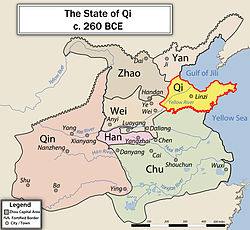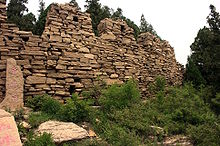- Qi (Shandong)
-
This article is about the major Zhou Dynasty State of Qí (齊). For the minor state Qǐ (杞), see Qi (Henan).
State of Qi Kingdom ← 
←
1046 BC–221 BC  →
→
 →
→Map of State of Qi in 260 BC Capital Linzi Religion Chinese folk religion, ancestor worship, Legalism Government Monarchy, Feudalism Chancellor - 685 BCE–645 BCE Guan Zhong History - Established 1046 BC - Defeated by Qin 221 BC Currency Chinese coin Qi (Shandong) Traditional Chinese 齊國 Simplified Chinese 齐国 Transcriptions Mandarin - Hanyu Pinyin Qí guó Min - Hokkien POJ chê-kok / chôe-kok - Min-dong BUC Cà̤-guók Wu - Romanization Zi/zhi koh/kueh Qi (simplified Chinese: 齐; traditional Chinese: 齊; pinyin: Qí; Wade–Giles: Ch'i) was a powerful state during the Spring and Autumn Period and Period of the Warring States in ancient China. Its capital was Linzi, now part of the modern day city of Zibo in Shandong Province.
Qi was founded around in 1046 B.C. as one of the many vassal states of the Zhou Dynasty. The first ruler of Qi was Jiang Shang, the most powerful official during that time. The Jiang family ruled Qi for several centuries before it was replaced by the Tian family in 386 BC. In 221 BC, Qi was the last state of pre-Imperial China to be conquered by the State of Qin, the final obstacle which allowed the Qin Dynasty to consolidate the first centralized and imperial empire over China.
Contents
History
Western Zhou (1046–771 BC): With the founding of the Zhou dynasty in 1046 BC, King Wu of Zhou assigned the conquered lands as hereditary fiefs to his relatives and ministers. Territory in the area of modern day Shandong was given to Jiang Ziya, his most important general from which the state of Qi arose.[1] Little information survives from this period. King Yi of Zhou (Ji Xie) (865-858) attacked Qi and boiled the Duke of Qi in a ding or cauldron. At the time of King Xuan of Zhou (827-782) there was a succession struggle. During this time many of the native Dongyi peoples were absorbed into the Qi state.
Spring and Autumn Period (771–480 BC): In 706 Qi was attacked by the Shan Rong. Qi rose to prominence under Duke Huan of Qi (685–643). He and his minister Guan Zhong strengthened the state by centralizing it. He annexed 35 neighboring states [2] and brought others into submission. In 667 Duke Huan met with the rulers of Lu, Song, Chen and Zheng and was elected leader. Subsequently King Hui of Zhou appointed him 'Ba' or Hegemon. He attacked Wei for supporting a rival of the Zhou king and intervened in the affairs of Lu. In 664 he protected Yan from the Rong. In 659 he protected Xing and in 660, Wei, from the Chi Di. In 656 he blocked the northward expansion of Chu. After his death, his sons quarreled and the hegemony passed to Jin.
In 632 Qi helped Jin defeat Chu at the Battle of Chengpu. In 589 Qi was defeated by Jin. In 579 the four great powers of Qin (west), Jin (center), Chu (south) and Qi (east) met to declare a truce and limit their military strength. In 546 a similar four-power conference recognized several smaller states as satellites of Qi, Jin and Qin.
Warring States Period (480–221 BC): The many wars of this age are described in the appropriate article. This section covers domestic affairs. Early in the period Qi annexed a number of smaller states. Qi was one of the first states to patronize scholars. In 532 the Tian (田) clan destroyed several rival families and came to dominate the state. In 485 the Tian killed the ducal heir and fought several rival clans. In 481 the Tian chief killed a puppet duke, most of the ruler's family and a number of rival chiefs. He took control of most of the state and left the Duke with only the capital of Linzi and the area around Mount Tai. In 386 the Tian family replaced the Jiang family as dukes. In 221 Qi was the last of the warring states to be conquered by Qin, thereby putting an end to the wars and uniting China under the Qin Dynasty.
Rulers of Qi
House of Jiang (姜)
- Jiang Shang, Duke Tai of Qi 吕尚; 姜子牙 齊太公 ?-1000 BC
- Lüji, Duke Ding of Qi 伋 齊丁公 999–? BC
- De, Duke Yi of Qi 得 齊乙公 ?–? BC
- Cimu, Duke Gui of Qi 慈母 齊癸公 ?–? BC
- Buchen, Duke Ai of Qi 不辰 齊哀公 ?–863 BC
- Jing, Duke Hu of Qi 靜 齊胡公 862–860 BC
- Shan, Duke Xian of Qi 山 齊獻公 859–851 BC
- Shou, Duke Wu of Qi 壽 齊武公 850–825 BC
- Wuji, Duke Li of Qi 無忌 齊厲公 824–816 BC
- Chi, Duke Wen of Qi 赤 齊文公 815–804 BC
- Shuo, Duke Cheng of Qi 脫 齊成公 803–795 BC
- Shu, Duke Zhuang of Qi 購 齊前莊公 794–731 BC
- Lufu, Duke Xi of Qi 祿甫 齊釐公 730–698 BC
- Zhu'er, Duke Xiang of Qi, son of Duke Xi, murdered by Lian Cheng and Guan Zhifu 諸兒 齊襄公 697–686 BC
- Wuzhi, younger cousin brother of Duke Xiang, created by Lian Cheng and Guan Zhifu but soon killed by Yong Ling 公孙無知 686 BC
- Xiaobai, Duke Huan of Qi, younger brother of Duke Xiang 小白 齊桓公 685–643 BC
- Wukui (Wugui), eldest son of Duke Huan, soon hanged 無詭 643 BC
- Zhao, Duke Xiao of Qi, younger brother of Wukui and heir of Duke Huan 昭 齊孝公 642–633 BC
- Pan, Duke Zhao of Qi, younger brother of Duke Xiao, it was said that his supporters murdered son of Duke Xiao 潘 齊昭公 632–613 BC
- She, son of Duke Zhao, soon murdered by his uncle Shangren 舍 613 BC
- Shangren, Duke Yi of Qi, murdered by two ministers and his heir was deposed 商人 齊懿公 612–609 BC
- Yuan, Duke Hui of Qi, elder brother of Duke Yi 元 齊惠公 608–599 BC
- Wuye, Duke Qin of Qi, son of Duke Hui 無野 齊頃公 598–582 BC
- Huan, Duke Ling of Qi, who made his son Ya who was born by his favorite concubine his heir instead of his eldest son, Guang, despite the tradition of selecting heirs. When he was ill, Guang returned and killed Ya with help of Cui Zhu and Qing Feng. He died upon hearing the fact 環 齊靈公 581–554 BC
- Guang, Duke Zhuang of Qi, had a liaison with wife of Cui Zhu and so was murdered by soldiers instructed by Cuizhu and some other ministers and generals 光 齊後莊公 553–548 BC
- Chujiu, Duke Jing of Qi (simplified Chinese: 杵臼 齐景公; traditional Chinese: 杵臼 齊景公; pinyin: Jiāng Chǔjiù, Qí Jǐng Gōng), younger brother of Duke Zhuang 547–490 BC
- Tu, Yan Ruzi, youngest and favorite son as well as heir to Duke Jing, soon deposed by ministers led by Chen/Tian Qi in behalf of his eldest brother Yangsheng and killed 荼 齊晏孺子 489 BC
- Yangsheng, Duke Dao of Qi, poisoned by Bao Xi out of advice of Chen/Tian Heng 陽生 齊悼公 488–485 BC
- Ren, Duke Jian of Qi, son of Duke Dao, killed by House of Chen/Tian 壬 齊簡公 484–481 BC
- Ao, Duke Ping of Qi, younger brother of Duke Jian 驁 齊平公 480–456 BC
- Ji, Duke Xuan of Qi 積 齊宣公 455–405 BC
- Dai, Duke Kang of Qi 貸 齊康公 404–379 BC
House of Tian (田)
Subjects of House of Jiang
- Tian Wan, Jing Zhong of Tian 田敬仲 陳完
- Tian Zhi 田孟夷 田穉
- Tian Min 田孟莊 田湣
- Xuwu, Wenzi of Tian 田文子 田須無 ?–545 BC
- Wuyu, Huanzi of Tian 田桓子 田無宇 ?–532 BC
- Kai, Wuzi of Tian 田武子 田開 ?–516 BC
- Qi, Xizi of Tian 田僖子 田乞 ?–484 BC
- Chang, Chengzi of Tian 田成子 田恆 ?–468 BC
- Pan, Xiangzi of Tian 田襄子 田盤
- Bai, Zhuangzi of Tian 田莊子 田白 ?–411 BC
- Daozi of Tian 田悼子 410–405 BC
- He, Duke Tai of Tian, 田太公 田和 recognized as Duke of Qi by King of Zhou 404–384 BC
Replaced House of Jiang
- He, Duke Tai of Tian 齊太公 田和 404–384 BC
- Shan, Duke Fei of Qi 齊廢公 田剡 383–375 BC
- Wu, Duke Huan of Qi 齊桓公 田午 374–357 BC
- Yinqi, King Wei of Qi 齊威王 田因齊 356–320 BC
- Pijiang, King Xuan of Qi 齊宣王 田辟彊 319–300 BC
- Di, King Min of Qi, "Emperor of the East" 齊愍王 田地 300–283 BC
- Fazhang, King Xiang of Qi 齊襄王 田法章 283–265 BC
- Jian, King of Qi 齊廢王 田建 264–221 BC
Conquered by Qin
Qi in astronomy
Qi is represented by the star Chi Capricorni in asterism Twelve States, Girl mansion.[3] Qi is also represented by the star 112 Herculis in asterism Left Wall, Heavenly Market enclosure(see Chinese constellation).[4]
References
- ^ Eberhard, Wolfram (1966). A History of China. ISBN 160303420X. p.63
- ^ These states included the State of Tan.
- ^ (Chinese)http://zh.wikipedia.org/wiki/%E5%8C%97%E6%96%B9%E4%B8%AD%E8%A5%BF%E6%98%9F%E5%90%8D%E5%B0%8D%E7%85%A7%E8%A1%A8
- ^ (Chinese)http://zh.wikipedia.org/wiki/%E5%8C%97%E5%A4%A9%E4%B8%AD%E8%A5%BF%E6%98%9F%E5%90%8D%E5%B0%8D%E7%85%A7%E8%A1%A8
Further reading
- Michael Loewe, ed (2006). The Cambridge history of ancient China: from the origins of civilization to 221 B.C.. Cambridge: Cambridge Univ. Press. ISBN 978-0-521-47030-8; 0-521-47030-7.
- Glessner Creel, Herrlee (1979). The birth of China: a study of the formative period of Chinese civilization. New York: Ungar Publ.. ISBN 0-8044-6093-0; 0-8044-1205-7.
See also
Zhou Dynasty topics Spring and Autumn Warring States Minor StatesCategories:- Former countries in East Asia
- States and territories established in 1046 BC
- 221 BC disestablishments
- Ancient Chinese states
- Qi (Shandong)
Wikimedia Foundation. 2010.




